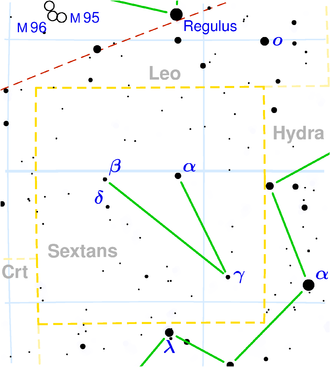NGC 2979
| Galaxy NGC 2979 / NGC 3050 |
|
|---|---|

|
|
| AladinLite | |
| Constellation | sextant |
|
Position equinox : J2000.0 , epoch : J2000.0 |
|
| Right ascension | 09 h 43 m 08.6 s |
| declination | -10 ° 23 '00 ″ |
| Appearance | |
| Morphological type | (R ') SA (r) a? / Sy2 |
| Brightness (visual) | 12.7 mag |
| Brightness (B-band) | 13.6 mag |
| Angular expansion | 1.5 '× 1.0' |
| Position angle | 30 ° |
| Surface brightness | 13.0 mag / arcmin² |
| Physical data | |
| Redshift | 0.009073 ± 0.000050 |
| Radial velocity | 2720 ± 15 km / s |
|
Stroke distance v rad / H 0 |
(114 ± 8) · 10 6 ly (34.8 ± 2.4) Mpc |
| history | |
| discovery | William Herschel |
| Discovery date | March 25, 1786 |
| Catalog names | |
| NGC 2979 • NGC 3050 • PGC 27795 • MCG -02-25-012 • IRAS 09407-1009 • 2MASX J09430865-1022596 • GC 1907 • H III 521 • h 631 • NVSS J094308-102259 | |
NGC 2979 = NGC 3050 is a spiral galaxy with an active nucleus of the Hubble type Sa in the constellation Sextant in the southern sky . It is estimated to be 114 million light-years away from the Milky Way and has a diameter of about 50,000 ly
. a. the galaxies NGC 2978 and NGC 2980 .
The object was discovered on March 25, 1786 by the astronomer Wilhelm Herschel .
